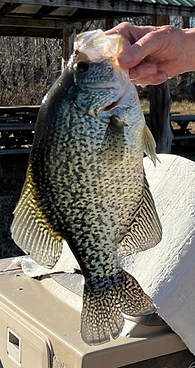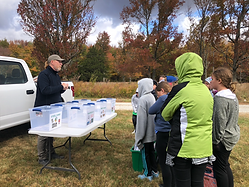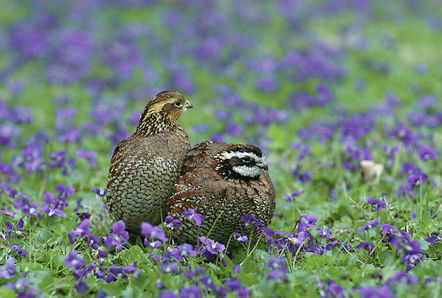

Big Oaks Big Six






1. Wildlife Observation
Within 50,000 acres of well kept land that the friend's group helps maintain, there is a seemingly endless opportunity to view a variety of natural wonders.
A favorite wildlife viewing opportunity is the countless birds that utilize the refuge throughout all seasons. Migratory species like Cerulean Warblers, Worm-eating Warblers, and Henslow's sparrows can be seen on the refuge.
White-tailed deer are common throughout the refuge, as well as river otters, squirrels, and the occasional coyote or bobcat. Furthermore, Big Oaks is home to the state endangered Crawfish Frogs. Other herpetofauna on the refuge includes Marble Salamanders, Bull Frogs, Southern Leopard Frogs!
In addition to our wildlife, in the prairie portion of the refuge you will find an incredible assortment of wildflowers. Bidens, milkweed, boneset, mountain mint, and so many more provide a beautiful landscape of color and an enticing fragrant atmosphere. These flowers peak in late summer to the early fall. They provide habitat for Monarch Butterflies and other beautiful insects.
Included in the refuge is Old Timbers Lake which is roughly 150 acres and currently home to a breeding pair of bald eagles. At Big Tree Point there is a wildlife observation deck built by some of our BOCS members. Other habitat on the refuge is wetlands that is home to beavers and wood ducks.
The diverse wildlife and landscape create excellent wildlife viewing opportunities. Join us for our Christmas Bird Count or North American Butterfly Count! Volunteers are always welcome to assist with Crawfish Frog surveys in the spring and the North American Butterfly Survey in mid-summer.
1a. Observation (Birding)
Bird watching is a popular activity here at Big Oaks. An assortment of species of birds utilize the refuge throughout the seasons. The birding opportunity at Big Oaks is enjoyed by novice, intermediate and advanced birders.
Approximately 120 species of birds are documented nesting on the refuge and over 200 migrate through. The variety of habitat including large blocks of forest, wetlands, and grassland fosters a diversity of bird species. For example: Wood Ducks can commonly be seen in our wetlands, Cerulean Warblers nest at the tops of tall trees, and Henslow's Sparrows inhabit the vast grasslands.
A pair of breeding Bald Eagles currently resides at Old Timbers Lake. The lake is also home to Belted Kingfishers and a variety of waterfowl species. Canada Geese, Pied-billed Grebes, Mallards, and other waterfowl can be viewed here.
In our grasslands, the Henslow's sparrow takes the spotlight. Populations of this species are currently in decline due to a loss of their preferred habitat, grasslands. The Refuge is crucial in providing breeding habitat for this species. Other birds of the grasslands include Dickcissels, many different sparrows, and a wintering Golden Eagle.
The forests on Big Oaks range from mature to early successional. They provide home to woodpeckers, warblers, Red-shouldered Hawks, and many more.
Big Oaks NWR is a Globally Important Bird Area. Several species here are listed as a special management concern for the Fish and Wildlife Service. These include Red-headed Woodpeckers, Acadian Flycatchers, Wood Thrush, Blue-winged Warbler, Kentucky Warbler, Field Sparrow, Grasshopper Sparrow, Henslow's Sparrow, Eastern Meadowlark, and Orchard Oriole.
Projects involving birds have occured in the refuge. Blue bird boxes and Kestrel boxes provide nesting areas for these birds in addition to information about the species. Henslow's Sparrow surveys are the most recent bird-related project. Big Oaks Conservation Society members frequently volunteer in aid of bird surveys, tours, and more. Join us for the annual Christmas Bird Count where Golden Eagles, Short-eared Owls, and LeConte's Sparrows have been highlights of previous counts.
Big Oaks has had visitors from all over the U.S. and the world in pursuit of this hobby. Private bird tours are available upon request with the Big Oaks Office.









2. Fishing
Fishing is permitted on Old Timbers Lake in the public access areas on public use days. Boats are permitted on the lake, however motors are limited to electric trolling motors only. There is a 30 boat limit on the lake, with access being on a first-come first-served basis. The limit applies to all boats, whether fishing or not; canoes and kayaks are permitted.
Panfish and bass are abound in the 150 acres of the lake.
All state fishing regulations apply, in addition any bass 12-15" must be put back in the lake. A fishing brochure is available at the Refuge office.
Many BOCS members are among the most avid fishermen on Old Timbers Lake. Fishfries, utilizing fish caught in Old Timbers Lake, are a favorite activity of Big Oaks Members. Friends of Big Oaks also co-sponsors Take a Kid Fishing Day, our effort to promote fishing as a sport and outdoor experience to the youth of our area.
3. Hunting
Hunting is an important recreational activity at Big Oaks. Visitors may participate in squirrel, wild turkey, and white-tailed deer hunting! These activities provide enjoyment and sustenance for the public while also providing refuge staff with important information about these populations. All hunters on the refuge are required to hunt with a partner and a compass. Individual units within the refuge can be selected.
Additionally, hunters of wild turkey can put in to be drawn for hunts on the refuge through the state in addition to a local drawing for two weekends in May. Please contact the refuge office or the refuge website for more information.
Squirrel hunting is allowed on our Public Use days during the state season. There is no bag limit.
Mushroom hunting is also allowed on the refuge. Similar to the deer and turkey hunts, hunters must pick a hunting area. Unlike the deer and turkey hunts, if a mushroom hunter would like to change areas they are allowed. Mushroom hunters must return to the office and let the Big Oaks staff know they want to change hunting areas.
There are dates for archery, primitive (muzzleloader) and firearm hunts on the refuge. Hunters must be drawn through the state for these hunts. There will also be a no-show drawing every hunt morning.
Refer to specific refuge regulations for more information. Contact the refuge office or website for updates and additional information.
All hunters must view the refuge safety briefing prior to access to the refuge. Hunt permits must be purchased at the refuge office for $20. These permits are valid for one year. Hunt fees are reduced by half for holders of an interagency access/senior pass and waived for those aged 15 and younger. View the Rules and Regulations page for more information regarding hunting at Big Oaks National Wildlife Refuge.




4. Interpretation
It is our goal to develop the interpretive potential of Oakdale School and OldTimbers Lodge, and expand joint projects with local schools and conservation organizations.
The Refuge itself may provide general or focused guided tours, depending on the number of staff and Rangers available. Tours must be arranged in advance with the Refuge office.
5. Education
Big Oaks Conservation Society supports the educational mission and activities through the co-sponsorship of Outdoor Women at Big Oaks, Take a Kid Fishing Day, Youth Deer Hunt, and Youth Turkey Hunt Workshops. Big Oaks Conservation Society has engaged in joint projects with Hanover College and local Scout Troops as well.



6. Wildlife Photography
Photography is permitted in any area of the Refuge the visitor is authorized to enter.
The lake is a great place to take picture of our beautiful wildlife!
Share your picture with us!


Other activities: Hiking
Hiking is available in public use areas, which are open only on public use days.
A few developed trails do exist and visitors are welcome to use them or walk the gravel roads in the day use area. There are copious opportunities for nature observation and photography despite the limited access to certain areas of the Refuge.
While hiking, you will see the many different landscapes that are on the refuge. The public use area is filled with mature hardwood forest as well as tracts of younger-aged stands. You will also see prairie habitat where there are wildlflowers that blanket the ground throughout different parts of the year.
Pets must be kept on a leash. Camping, fires, and swimming are prohibited. Off-road vehicles are not permitted on the Refuge.


